Bill Young revives his Interleaving at 100 Grand Street, December 9 through 11.
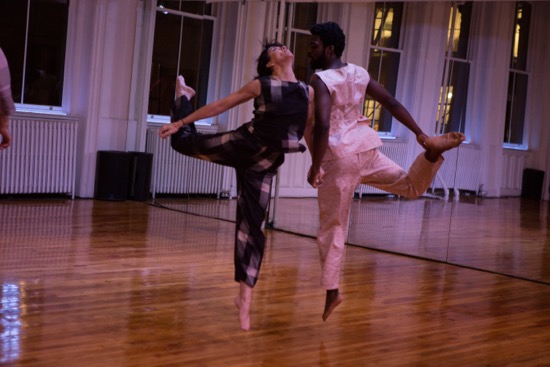
Colleen Thomas and Oluwadamilare Ayorinde in Bill Young’s Interleaving. Photo: Julia Discenza
I was beginning to write about Bill Young’s revival of his Interleaving after he’d given it a 30-year vacation, when my planned opening struck a chord. Yes, there it was, the start of my 2013 review of A Place in France (a collaboration between Young and his wife, Colleen Thomas): me at 100 Grand Street, standing in a line that wound up splintery stairs past walls with peeling paint, waiting for the door to their loft studio.
There, I wrote it again, and I think that’s because nostalgia is kicking in. A Soho space like this was not uncommon in the 1970s when Young first presented Interleaving. Some choreographers could roll out of bed in the morning, make coffee, and walk a few steps to a big area with mirrors and maybe a smooth wooden floor and get to work. Who minded, say, walking through Meredith Monk’s kitchen to get to a performance in her studio?
And while the three or four dozen people are packing onto folding chairs on this loft’s risers and the front-row floor cushions, I’m having a love affair with the beautiful, glowing wood floor. How often do you see that in a dance studio these days? The place is so immaculate that I cherish a single homey flaw: one of the three white-painted radiators positioned between the five windows is slightly askew, a leg propped up on something. Strings of little lights (blue or green) intermittently outline the windows or their sills (part of Joe Levasseur’s ingenious lighting).
The dancers can come and go through two doors or from behind the spectators, and come and go, they most certainly do. For Interleaving, Young created four separate dances: Wall Unfolding (an all female quintet), Double Bill (a trio), and two quartets, Music Minus One and Sambosamba. Unlisted in the program is his own intermittent role and his duet with Thomas. The overall title reflects the process with which he wove the parts of Interleaving together. In a program note, he wrote of the four dances being “sewn together,” as in publishing, where “interleaving” refers to the insertion of pages between main pages of a book. These are usually blank. Not here. One group may pass through another or surround it or work the background, even though each has sequences when it alone occupies the space.
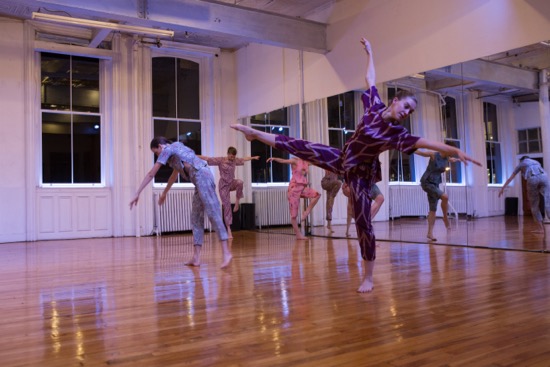
Bill Young’s Interleaving. Foreground: Jamie Scott. Behind her (L to R): Lauren Ferguson, Lindsey Jones, Cori Kresge, Lisa Boudreau, and their reflections. Photo: Julia Discenza
Two factors make these possibilities ever more complicated. Cori Kresge and Pierre Guilbault figure in two of the four groups. And, bewitchingly, the mirrored wall to the right of the spectators multiplies the dancers and reveals hidden ones. The movement, for the most part, is both big and precise. The fifteen dancers’ long legs carve the air (I say that not because all of them have certifiably long legs—they don’t—but because of the straight, swinging, thrusting ways in which they use them). Their feet frisk; they’re often springing and leaping.
You can surmise that Young was taking classes in Merce Cunningham’s studio when he made Interleaving (he danced in Deli Commedia, a film that Cunningham and Elliott Caplan made in 1984), and he teaches that technique. Also, two of the performers—Jamie Scott and Lisa Boudreau— were once members of the Merce Cunningham Dance Company and two others beside Scott—Kresge and Lauren Ferguson—worked in Cunningham’s Repertory Understudy Group. So although the dancing is occasionally tender or rough-edged and quite individual (Darrin Wright, for instance has a different quality from that projected by Guilbault), it’s not quite as sensual as Young’s more recent work.
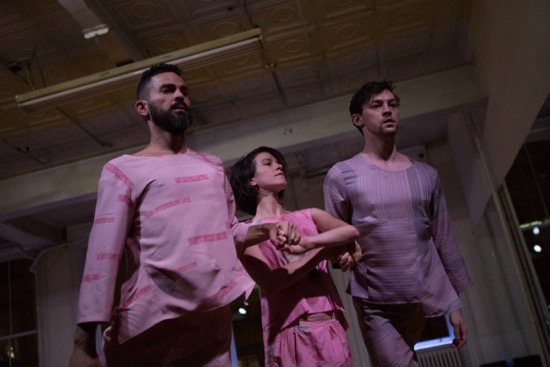
(L to R): David Rafael Botana, Cori Kresge, and Pierre Guilbault. Photo: Julia Discenza
The dance unfolds to vivid, changeable music—some by Wayne Horvitz, some by Arthur Solari. Maybe it’s the latter’s that sounds like cans being banged on in the dark as Interleaving is starting. We first see the trio in action when Kresge pulls Guilbault and David Rafael Botana into the space. But this is also where we meet, as I recall, Lauren Ferguson and then Scott, who are still there when a higher sound chimes in, and Thomas enters with Gary Champi, Oluwadamilare Ayorinde, and Guilbault. These four clump up, jitter around one another, and pair up while percussive sounds invade a patch of liquid music.
Stop. I should mention how great everyone looks. And this is not just because they’re all vibrant, skilled, interesting dancers, but because of Rachel Jones Bellas’s terrific costumes; the outfits—trousers and loosely cut tops with sleeves of varying lengths—are patterned, none alike, with lines, flowers, plaids, writing, et al. There’s no mixing up Champi, say, who’s wearing red, with any of the other men. When Sarah Haarmann and Erin Down first make themselves known with Wright and Gabrielle Revlock; they, both pony-tailed and medium-sized, soaring around, fix themselves in your mind as “she in deep pink” and “she in beige.” Wright can embrace them both and run with them.
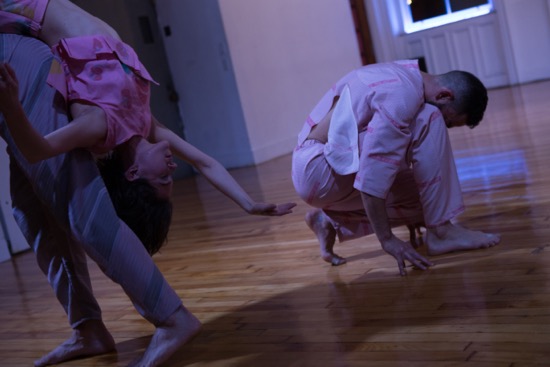
Bill Young’s Interleaving. (L to R): Pierre Guilbault bearing Cori Kresge and (R) David Rafael Botana. Photo: Julia Discenza
The interleaving is subtle. Once, as I recall, Guilbault is carrying Kresge off, and Young intervenes to hook her away so that Guilbault can drop down beside Botana, who’s waiting there. When Lindsey Jones and Boudreau make their first appearance, they join Scott, Ferguson, and Kresge to line up before us as the unit we may have forgotten they are part of. People from two groups may fade into three duets. Wright dances with Revlock, while Dowd and Haarmann hold down two corners, yet Kresge is performing her own material between them. Sometimes a person from one group seems to lure another into his/her precinct; at other times, a flock may race through some quieter dancing. The lights and sound may fade and brighten, or grow louder.
Champi and Ayorinde, embracing or in a ballroom hold, make two entrances into the space while Young and Thomas are performing what could be considered a surprise-filled pas de deux à terre. That is, almost all of it takes place with the two on the floor—first wrapped around one of the room’s two fat pillars, each grasping the other’s arm or ankle, then finding ways to maneuver around their two clasped hands. Actually, there are many surprises—not the least of them Scott, right at the end, dancing alone in sudden strobe light, while a melody is overcome by thunder and heavy drumbeats.
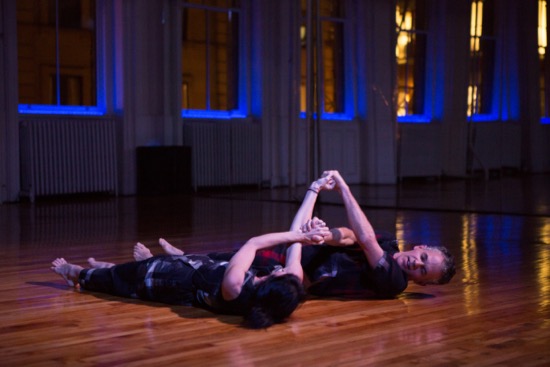
Colleen Thomas and Bill Young intertwine. Photo: Julia Discenza
Being this close to the dancers means that you often have to turn your head to pursue a couple or look more closely at something that caught your eye off to the left. Maybe you decide to peruse a grouping in the mirror. Watching the performers—busy, intrepid, athletic, following an intricate scheme—you want to get to know them better, to admire how this one attacks that movement, or falls into that design. It’s not often that I wish I could see a dance a second time, so I could catch what I missed. This was, oh yes, one of those times.
